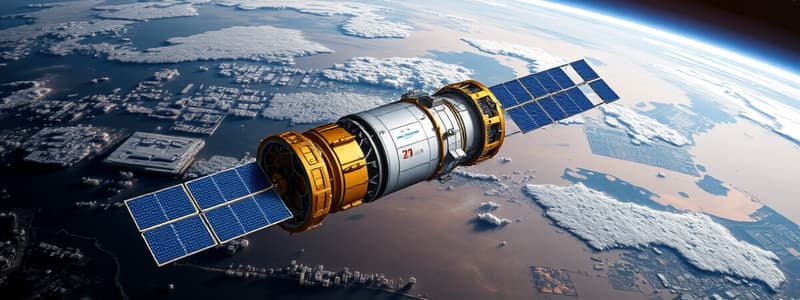Podcast
Questions and Answers
What is the main objective of ISRO?
What is the main objective of ISRO?
- To harness space technology for national development. (correct)
- To create international partnerships for military applications.
- To focus solely on commercial satellite launches.
- To conduct human experiments in space.
Which launch vehicle is designed for launching heavier payloads into geosynchronous orbit?
Which launch vehicle is designed for launching heavier payloads into geosynchronous orbit?
- SSLV (Small Satellite Launch Vehicle)
- PSLV (Polar Satellite Launch Vehicle)
- SLV (Satellite Launch Vehicle)
- GSLV (Geosynchronous Satellite Launch Vehicle) (correct)
Who is the founder of ISRO?
Who is the founder of ISRO?
- Vikram Sarabhai (correct)
- Dr. A.P.J. Abdul Kalam
- K. Sivan
- Satish Dhawan
What significant discovery was made by Chandrayaan-1?
What significant discovery was made by Chandrayaan-1?
What is the primary focus of ISRO's satellite development program?
What is the primary focus of ISRO's satellite development program?
Which of the following missions is part of ISRO's future plans?
Which of the following missions is part of ISRO's future plans?
How does ISRO contribute to society?
How does ISRO contribute to society?
What is one notable fact about ISRO's missions?
What is one notable fact about ISRO's missions?
Flashcards are hidden until you start studying
Study Notes
Overview of ISRO
- Full Form: Indian Space Research Organisation
- Founded: August 15, 1969
- Headquarters: Bengaluru, India
- Founder: Vikram Sarabhai
Objectives
- To harness space technology for national development.
- To conduct space research and planetary exploration.
Key Achievements
-
Satellite Launches:
- Development and launch of indigenous satellites (INSAT, IRS).
- Successful launch of foreign satellites.
-
Launch Vehicles:
- PSLV (Polar Satellite Launch Vehicle): Notable for launching satellites into polar orbits.
- GSLV (Geosynchronous Satellite Launch Vehicle): Designed for launching heavier payloads into geosynchronous orbit.
-
Chandrayaan Missions:
- Chandrayaan-1: India's first mission to the Moon (2008), discovered water molecules.
- Chandrayaan-2: Launched in 2019, aimed at a soft landing on the Moon.
-
Mangalyaan (Mars Orbiter Mission):
- Launched in November 2013.
- First Indian mission to Mars, making India the first Asian nation to reach Martian orbit.
Key Programs
- Satellite Development: Focus on communication, weather forecasting, and Earth observation.
- Space Science: Research in astrophysics, planetary science, and space weather.
International Collaborations
- Partnerships with various space agencies (NASA, ESA, etc.).
- Launching satellites for other countries, enhancing global space partnerships.
Future Plans
- Gaganyaan: India’s first manned spaceflight program.
- Aditya-L1: Mission to study the Sun.
- Chandrayaan-3: Follow-up lunar exploration mission.
Contributions to Society
- Applications in agriculture, communication, disaster management, and urban planning.
- Advancements in technology that benefit various sectors.
Organizational Structure
- Divided into multiple centers focusing on various aspects (satellite development, launch vehicles, etc.).
Notable Facts
- ISRO is known for its cost-effective missions.
- Made significant advancements in satellite technology and launch capabilities in a short period.
Overview of ISRO
- Indian Space Research Organisation established on August 15, 1969, focuses on space technology for national development.
- Headquarters located in Bengaluru, India; founded by renowned scientist Vikram Sarabhai.
Objectives
- Utilizes space technology to boost national development efforts.
- Conducts extensive research in space and planetary exploration.
Key Achievements
- Satellite Launches: Developed indigenous satellites such as INSAT (communications) and IRS (remote sensing) while successfully launching foreign satellites.
- Launch Vehicles:
- PSLV (Polar Satellite Launch Vehicle): Recognized for ability to launch satellites into polar orbits, known for reliability.
- GSLV (Geosynchronous Satellite Launch Vehicle): Engineered to launch heavier payloads into geosynchronous orbits, enhancing capacity for major missions.
- Chandrayaan Missions:
- Chandrayaan-1: Launched in 2008, marked India's first lunar mission, credited with the discovery of water molecules.
- Chandrayaan-2: Initiated in 2019, aimed for a soft landing, furthering lunar exploration efforts.
- Mangalyaan (Mars Orbiter Mission): Successfully launched in November 2013, making India the first Asian nation to achieve Martian orbit and highlighting India’s capabilities in interplanetary exploration.
Key Programs
- Satellite Development: Emphasizes extensive work in communication, weather forecasting, and Earth observation technologies.
- Space Science: Conducts research in areas such as astrophysics, planetary science, and analysis of space weather phenomena.
International Collaborations
- Establishes partnerships with prominent space agencies like NASA and ESA, enhancing collaborative efforts.
- Engages in launching satellites for other countries, solidifying global space relations.
Future Plans
- Gaganyaan: Envisions India’s inaugural manned spaceflight program, marking a significant milestone.
- Aditya-L1: Planned mission for studying solar phenomena and understanding the Sun’s impact on the Earth’s environment.
- Chandrayaan-3: A follow-up mission aimed at continuing lunar exploration after Chandrayaan-2's findings.
Contributions to Society
- Applications of ISRO's technologies notably benefit sectors such as agriculture, communications, disaster management, and urban planning.
- Innovations have resulted in advancements that enhance capabilities across multiple industries.
Organizational Structure
- Structured into various specialized centers focusing on different elements such as satellite development and rocket launch systems.
Notable Facts
- Recognized for conducting cost-effective space missions and significant satellite technology advancements within a short timeframe.
- Demonstrates a commitment to rapidly enhance launch capabilities and establish a strong presence in global space exploration.
Studying That Suits You
Use AI to generate personalized quizzes and flashcards to suit your learning preferences.



